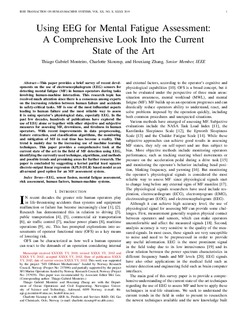| dc.contributor.author | Monteiro, Thiago Gabriel | |
| dc.contributor.author | Skourup, Charlotte | |
| dc.contributor.author | Zhang, Houxiang | |
| dc.date.accessioned | 2019-09-24T10:28:55Z | |
| dc.date.available | 2019-09-24T10:28:55Z | |
| dc.date.created | 2019-09-20T12:49:34Z | |
| dc.date.issued | 2019 | |
| dc.identifier.citation | IEEE Transactions on Human-Machine Systems. 2019, . | nb_NO |
| dc.identifier.issn | 2168-2291 | |
| dc.identifier.uri | http://hdl.handle.net/11250/2618442 | |
| dc.description.abstract | This paper provides a brief survey of recent developments on the use of electroencephalogram (EEG) sensors for detecting mental fatigue (MF) in human operators during tasks involving human-machine interaction. This research topic has received much attention since there is a consensus among experts on the increasing relation between human failure and accidents in safety-critical tasks. MF is one of the most influential aspects leading to human failure and the most reliable way to assess it is using operator's physiological data, especially EEG. In the past few decades, hundreds of publications have explored the use of EEG alone or together with other objective and subjective measures for assessing MF, drowsiness, and tiredness in human operators. With recent improvements in data preprocessing, feature extraction, and classification algorithms, the monitoring and mitigation of MF in real time has become a reality. This trend is mainly due to the increasing use of machine learning techniques. This paper provides a comprehensive look at the current state of the art in the field of MF detection using EEG, identifying the currently used technique, algorithms, and methods and possible trends and promising areas for further research. The paper is concluded by suggesting a kernel partial least squares– discrete-output linear regression (KPLS-DLR) based model as an all-around good option for an MF assessment system. | nb_NO |
| dc.language.iso | eng | nb_NO |
| dc.publisher | Institute of Electrical and Electronics Engineers (IEEE) | nb_NO |
| dc.title | Using EEG for Mental Fatigue Assessment: A Comprehensive Look Into the Current State of the Art | nb_NO |
| dc.type | Journal article | nb_NO |
| dc.type | Peer reviewed | nb_NO |
| dc.description.version | acceptedVersion | nb_NO |
| dc.source.pagenumber | 12 | nb_NO |
| dc.source.journal | IEEE Transactions on Human-Machine Systems | nb_NO |
| dc.identifier.doi | 10.1109/THMS.2019.2938156 | |
| dc.identifier.cristin | 1727195 | |
| dc.relation.project | Norges forskningsråd: 237929 | nb_NO |
| dc.relation.project | Norges forskningsråd: 237896 | nb_NO |
| dc.description.localcode | © 2019 IEEE. Personal use of this material is permitted. Permission from IEEE must be obtained for all other uses, in any current or future media, including reprinting/republishing this material for advertising or promotional purposes, creating new collective works, for resale or redistribution to servers or lists, or reuse of any copyrighted component of this work in other works. | nb_NO |
| cristin.unitcode | 194,64,93,0 | |
| cristin.unitname | Institutt for havromsoperasjoner og byggteknikk | |
| cristin.ispublished | true | |
| cristin.fulltext | postprint | |
| cristin.qualitycode | 1 | |
